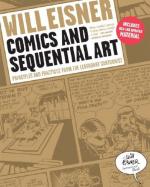
|
| Name: _________________________ | Period: ___________________ |
This test consists of 5 short answer questions, 10 short essay questions, and 1 (of 3) essay topics.
Short Answer Questions
1. In the Spirit story "Two Lives," which character is incarcerated?
2. What demonstrates the meaning of the balloon?
3. What do people learn to measure distance by?
4. What specific content does Chapter 4 discuss?
5. When are the outlines determined by the artist?
Short Essay Questions
1. What are used to move a reader/viewer through time?
2. Why is time more illusory in comics?
3. Why is text sometimes lettered in a style consistent with the sentiment of a scene?
4. Why do images without words require extra sophistication in the reader/viewer?
5. What is the function of balloons?
6. Why must the sequential artist and the reader share life experiences for communication to occur?
7. Give a brief synopsis of Chapter 4.
8. How do people normally measure distance?
9. Give a brief synopsis of Chapter 1: Comics as a Form of Reading.
10. Where does the emotion or "intuitiveness" of a panel come from?
Essay Topics
Write an essay for ONE of the following topics:
Essay Topic 1
In Chapter 6, Eisner discusses the history of repetitive glyphs and explains their importance in comics as a form of language. Compare and contrast the repetitive glyphs in early cave drawings, Egyptian friezes, hieroglyphics, and comics. How did these codes progress? How did comics draw upon and progress from these ancient examples?
Essay Topic 2
Eisner argues that comics and images can be "read." Explain the author's reasoning using two examples from the book. Defend or oppose Eisner's position.
Essay Topic 3
In Chapter 4, Eisner discusses the power of the artist to create work that seizes the attention of the audience. However, he declares that there are discrepancies between entertainment genres. Discuss the advantages or disadvantages that film and theater have over comics. Support your argument with three solid examples from Chapter 4.
|
This section contains 743 words (approx. 3 pages at 300 words per page) |

|




